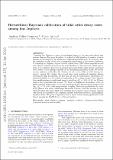Files in this item
Hierarchical Bayesian calibration of tidal orbit decay rates among hot Jupiters
Item metadata
| dc.contributor.author | Collier Cameron, Andrew | |
| dc.contributor.author | Jardine, Moira | |
| dc.date.accessioned | 2018-02-13T13:30:09Z | |
| dc.date.available | 2018-02-13T13:30:09Z | |
| dc.date.issued | 2018-05-11 | |
| dc.identifier | 252168277 | |
| dc.identifier | ac848f75-a559-4418-ba63-14ca74ec58a8 | |
| dc.identifier | 85046533697 | |
| dc.identifier | 000430940900085 | |
| dc.identifier.citation | Collier Cameron , A & Jardine , M 2018 , ' Hierarchical Bayesian calibration of tidal orbit decay rates among hot Jupiters ' , Monthly Notices of the Royal Astronomical Society , vol. 476 , no. 2 , pp. 2542-2555 . https://doi.org/10.1093/mnras/sty292 | en |
| dc.identifier.issn | 0035-8711 | |
| dc.identifier.other | Bibtex: urn:4ab8d2e506f98ee686a34948a774a715 | |
| dc.identifier.other | ORCID: /0000-0002-8863-7828/work/58531457 | |
| dc.identifier.other | ORCID: /0000-0002-1466-5236/work/57821880 | |
| dc.identifier.uri | https://hdl.handle.net/10023/12712 | |
| dc.description | ACC and MMJ acknowledge support from STFC Consolidated Grant ST/M001296/1. | en |
| dc.description.abstract | Transiting hot Jupiters occupy a wedge-shaped region in the mass ratio-orbital separation diagram. Its upper boundary is eroded by tidal spiral-in of massive, close-in planets and is sensitive to the stellar tidal dissipation parameter Q′s . We develop a simple generative model of the orbital separation distribution of the known population of transiting hot Jupiters, subject to tidal orbital decay, XUV-driven evaporation and observational selection bias. From the joint likelihood of the observed orbital separations of hot Jupiters discovered in ground-based wide-field transit surveys, measured with respect to the hyperparameters of the underlying population model, we recover narrow posterior probability distributions for Q′s in two different tidal forcing frequency regimes. We validate the method using mock samples of transiting planets with known tidal parameters. We find that Q′s and its temperature dependence are retrieved reliably over five orders of magnitude in Q′s. A large sample of hot Jupiters from small-aperture ground-based surveys yields log10Q′s = (8.26±0.14) for 223 systems in the equilibrium-tide regime. We detect no significant dependence of Q′s on stellar effective temperature. A further 19 systems in the dynamical-tide regime yield log10Q′s = 7.3±0.4, indicating stronger coupling. Detection probabilities for transiting planets at a given orbital separation scale inversely with the increase in their tidal migration rates since birth. The resulting bias towards younger systems explains why the surface gravities of hot Jupiters correlate with their host stars’ chromospheric emission fluxes. We predict departures from a linear transit-timing ephemeris of less than 4 seconds for WASP-18 over a 20-year baseline. | |
| dc.format.extent | 2206347 | |
| dc.language.iso | eng | |
| dc.relation.ispartof | Monthly Notices of the Royal Astronomical Society | en |
| dc.subject | Stars: planetary systems | en |
| dc.subject | Methods: statistical | en |
| dc.subject | Planets and satellites: dynamical evolution and stability | en |
| dc.subject | QB Astronomy | en |
| dc.subject | QC Physics | en |
| dc.subject | DAS | en |
| dc.subject.lcc | QB | en |
| dc.subject.lcc | QC | en |
| dc.title | Hierarchical Bayesian calibration of tidal orbit decay rates among hot Jupiters | en |
| dc.type | Journal article | en |
| dc.contributor.sponsor | Science & Technology Facilities Council | en |
| dc.contributor.sponsor | Science & Technology Facilities Council | en |
| dc.contributor.institution | University of St Andrews. School of Physics and Astronomy | en |
| dc.contributor.institution | University of St Andrews. St Andrews Centre for Exoplanet Science | en |
| dc.identifier.doi | https://doi.org/10.1093/mnras/sty292 | |
| dc.description.status | Peer reviewed | en |
| dc.identifier.url | https://arxiv.org/abs/1801.10561 | en |
| dc.identifier.grantnumber | ST/R00824/1 | en |
| dc.identifier.grantnumber | ST/M001296/1 | en |
This item appears in the following Collection(s)
Items in the St Andrews Research Repository are protected by copyright, with all rights reserved, unless otherwise indicated.

